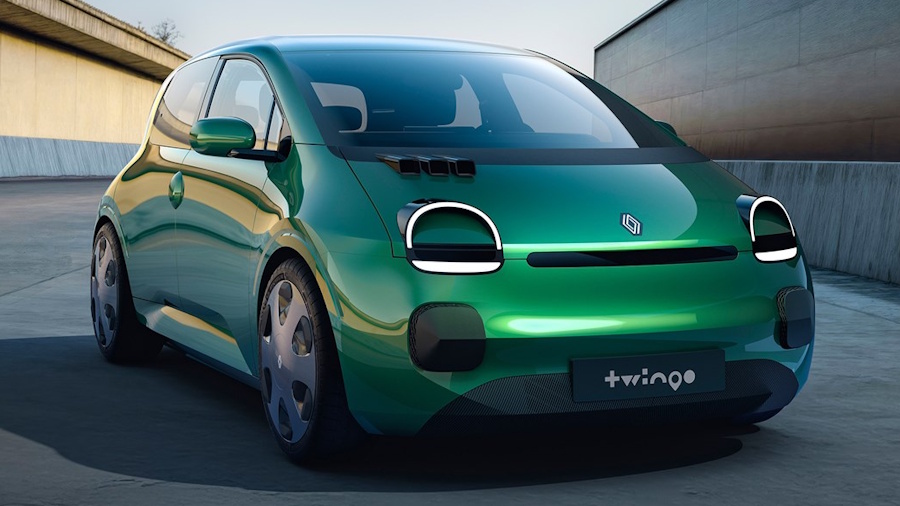Renault is bringing the Twingo back, but this time it’s fully electric, and it looks like they’ve really nailed it. The Twingo E‑Tech Electric is designed for city life, with five doors, smart tech, and a compact footprint that makes parking a breeze. Developed in under two years and built in Slovenia, it’s expected to hit European roads in early 2026, starting at under €20,000. If you’re looking for an affordable, practical EV that doesn’t feel tiny inside, this might just be the one.
Design
The Twingo E‑Tech Electric keeps the fun, friendly vibe of the original Twingo but packs in more practicality. It’s got five doors and clever interior packaging, so you get B-segment space in an A-segment car. There’s a 360-litre boot, 19 litres of extra cabin storage, plus a 50-litre compartment for your charging cable. Inside, you’ll find a 7‑inch digital cluster and a 10.1‑inch touchscreen with Google built-in. And underneath it all is Renault’s AmpR Small platform, designed to make EVs affordable while keeping them nimble and efficient around town.

Specs (Battery, Range, Power, Trunk)
| Specification | Value |
|---|---|
| Battery capacity | 27 kWh LFP (air‑cooled) |
| Estimated range (WLTP) | ~263 km |
| Motor output | 60 kW (≈82 hp) |
| Torque | 175 Nm |
| Drive layout | Front‑wheel drive (assumed) |
| Boot volume | 360 litres |
| Additional storage | 19 litres cabin + 50 litres for cable |
| Vehicle mass | 1,200 kg |
| Target price | Under €20,000 |
| Additional features | One‑pedal driving, V2L & V2G |
The car also comes with one-pedal driving, 24 driver-assistance features, and support for V2L (power your devices from the car) and V2G (feed energy back to the grid). It’s packed with urban-focused tech while keeping the price approachable.
Renault’s EV Strategy
The Twingo E‑Tech Electric isn’t just a city car, it’s part of Renault’s bigger push to make EVs accessible for everyone. The brand is rolling out small EVs like the Renault 5 and the Renault 4, all built on efficient platforms like AmpR Small and Medium. The idea is simple: keep the tech modern, the price reasonable, and the driving experience fun. With LFP batteries, European production, and a compact city footprint, Renault is trying to hit that sweet spot of affordable, practical, and connected EVs.
Competition in the European EV Market
If you’re looking at entry-level EVs in Europe, the Twingo E‑Tech Electric has some interesting rivals. There’s the BYD Dolphin Surf, a tiny EV with up to 322 km of WLTP range depending on battery size. The Leapmotor T03 is another compact option with about 265 km of range. And looking forward, Volkswagen is planning the ID.1, which should target the same sub‑€25,000 urban EV segment. What gives the Twingo an edge is its five doors, practical storage, and familiar Renault name, a combination that could make it a favorite for city drivers.

FAQ
When will the Renault Twingo E‑Tech Electric be available?
It’s set to launch in early 2026, shortly after the official introduction.
How far can it go on a single charge?
Renault is aiming for about 263 km WLTP, which is plenty for daily city and suburban trips.
How much will it cost?
The Twingo is expected to start at under €20,000, making it one of the most affordable EVs in Europe.
How practical is it?
With a 360-litre boot, plus 19 litres of cabin storage and a 50‑litre compartment for the charging cable, it’s surprisingly roomy for its size.
What features does it have?
One-pedal driving, 24 driver-assist systems, V2L and V2G functions, and a connected infotainment system with Google built in.
Who are its main competitors?
The Twingo will compete with the BYD Dolphin Surf, Leapmotor T03, and the upcoming VW ID.1 in the budget-friendly city EV market.






